SHIZUSABURO KANEUJI KEM-MU 1334: From Yamato. Worked in Nara from
Tegai roots. First signed with the HO form of KANE and began
earning acclaim. See his earlier pieces in: Yamato Shizu
He traveled to learn in Kamakura and then moved to Naoe in Mino,
altering his name to use the KEN "bushel" Kane-form.
All the Ten Students headed to new places when the Hojo had lost
power. Kamakura could no longer afford the many artists that
had set up careers there.
KANEUJI founds MINO with the NAOE SHIZU
MINO SHIZU:
Technical SUGATA - Shallow curve of gently tapered width.
HADA - Fine KO-MOKUME, ITA MASA mix. JI-NIE on clear,
moist blue steel. UZU. Some pronounced HADA in
the folds. CHIKEI.
HAMON - A few HIRO-SUGU, but mostly O-MIDARE, GUNOME-
TOGARI MIDARE, O-GUNOME O-NOTARE, and NOTARE-
MIDARE with KINSUJI and INAZUMA. NIE-TSUYU on
NIOI. SUNAGASHI and ASHI. NIJU.
BOSHI - MIDARE or KAEN. Some TOGARI. Little turnback.
NAKAGO - Many SURIAGE and usually with two character
signatures if any.
NAOE SHIZU were descendants. Their blades are lighter and of
less curvature but have otherwise similar characteristics.
See NAOE SHIZU School
"The Ten Students"
MINO-DEN Founder SHIZU KANEUJI GEN-O 1319
NAOE ______________|____________________________
________|____ _________|____ ____|____
SENA KANETOMO NAOE KANETOSHI TEI-WA 1345 KANETSUGU
____ ________| | _________|
| ___|____ ___|_____ | ________|____ ___|____
| KANEKUNI KANETSUGU | NAOE KANENOBU KANENOBU
| ________|_________ ________ ___|____
| SANAMI _______|____ ___|_____ ___|___ ___|____ KANENOBU
___|____ EI-KYO RI KANETOSHI KANETSUGU KANEUJI KANEHISA OWARI(2)
KANENORI 1429 ___|____
|_________ _________ KANEHISA
___|____ ___|____ ___|____
KANENORI KANEKUNI KANENAGA
___|____ ___|____
KANENORI KANEKUNI
"The Ten Students" - See The Ten Students
KANEUJI(1) KEM-MU (f: NAGAKANE(1): SHIZU Founder at Mino.
Buddhist name: SHIZUSABURO. From Nara Yuruki, -DOKI.
1st KANE form, YAMATO road-sign: HO "Wrap."
MINO KANE form: KEN. These were regional trademarks and
respected as such.
SHIZU is TEGAI roots. Old books say he was the son TEGAI
KANENAGA, the TEGAI dean. However, there are no ZAI-MEI
with this KANE. Only O-SURIAGE MU-MEI and logic would
therefore tell us to expect KANENAGA influence in his
early, YAMATO work. Attribution pieces have been
SUE-KAMAKURA style with wide and raised SHINOGI.
MASAME HADA. KO-GUNOME with clear NIE JI-BA along the line.
As one of the "Ten Students" it is taught that he moved
for study with SOSHU MASAMUNE and then traveled to MINO
where his KANE form changes to KEN "Combine." Note: the
"Ten Students" is largely a fanciful legend. There are
different smiths included, all great names of the time.
Some we know to have been a MASAMUNE peer at the least.
By the time of the troubles for the Kamakura Shikken, of
KEM-MU, KANEUJI has moved to rural MINO, setting up shop
in NAOE. Always check style: is it YAMATO SHIZU? or
SODEN SHIZU? Remember, KANEUJI(1) & (2) are teacher and
student, they dance at the same time. Therefore KEM-MU
to TEIWA 1345 is where to keep focus for KANEUJI(1).
Making TACHI and TANTO. Wide blades, IHORI-MUNE and
with normal KISSAKI-NAGA expected before the on-set of
NAMBOKUCHO styles.
ITAME has MASAME running. JI-NIE is particularly strong.
SUGUHA with KO-GUNOME-MIDARE and KO-NOTARE that becomes
NIJU from running SUNAGASHI and KINSUJI. NIE NBIOI-FUKASHI
BECOMES stronger in the mid.
TACHI will have radically varying JIBA, with MANY HAMON of
O-GUNOME MIDARE BA with swept HAKIKAKE NIE in and through
the HABUCHI and small TOBI-YAKI and YO.
Expected early BOSHI are NOTARE-KOMI HAKIKAKE to TEGAI
throw-back, YAKIZUMI KAERI. Later we may see deep ICHIMAE
with HAKIKAKE.
NAKAGO may be MARU-MUNE. 6 sun TANTO of MITSU-MUNE,
Noted work from KEM-MU 1334 and KANEUJI-style pieces are
seen to the MEI-TOKU 1390. This would make him a very old
man. Of course, KANEUJI signatures stretch all the way to
the SHIN-SHINTO. Always check the sword itself, they hold
secrets but never lie.
KANEUJI signatures are large and boxy, with squarish angles.
Early: YAMATO SHIZU, sedate, conservative. See YAMATO
Later shows SUNAGASHI and KINSUJI in more exuberant
O-GUNOME O-MIDARE BA with JIBA of TOBI in swept HAKIKAKE
YAKIBA.
MEI: KANEUJI
KANEUJI(2) EN-BUN (f: KANEUJI 1): TEI-WA 1345 to TEI-JI 1368.
Wide ENBUN O-KISSAKI NAMBOKUCHO blades emerge to full
flower from the style of KANEUJI(1). Made MITSU-MUNE
and MARU-MUNE. Mostly O-SURIAGE MUMEI are found. Signed
pieces are extremely rare.
KO-ITAME HADA with a little running MASA has JINIE and
CHIKEI.
KO-NIE DEKI SUGUHA, NOTARE lines of GUNOME and SODEN style
MIMIGATA will show SUNAGASHI. SUGU KO-MIDARE HA.
NIOI-DEKI GUNOME O-MIDARE and HITATSURA style.
His two-character MEI is done large. ZAIMEI may be
associated with his earlier SOSHU years as, later, MUMEI
became the NAOE SHIZU school tradition. MUMEI, SOSHU style
are found - however, while having developed their style
from their SOSHU MASAMUNE School roots, KANEUJI NAOE SHIZU
style pieces are the highest ranked.
Examples from the time of his late years are so changed,
they may simply be the work of other men.
MEI: KANEUJI
KANEUJI SAKU
KANEUJI O-AN: This work has been differentiated by MEI, by style
and in appraisal over the years. A known KINZOGAN gold inlay
piece specifies the KANE character as being rounded, exactly
as certain late KANEUJI, which establishes in scholarship, a
third man. The first and second KANEUJI are, essentially
earlier. They came through YAMATO and SOSHU times. In style
and signature we accept O-AN 1368 time for a third KANEUJI
making KO-ITAME HADA with MASAME in SHIZU style.
NOTARE holds GUNOME-MIDARE where there is YUBASHIRI and
TOBI-YAKI.
O-MARU and ICHIMAE BOSHI, typical of the NAMBOKUCHO but some-
what larger than the MARU of KANEUJI 2nd.
Also, OAN KANEUJI MEI are smaller and rounded, setting them
distinctly apart from the squarish and large KAKU-MEI of the
earlier generations.
OAN KANEUJI is SHIZU style of the NAOE Group and must be
considered the inheritor of the school.
KANEUJI
KANESADA OEI (t: KANEUJI(2): Originally from WAKASA.
WAKASAGORO SADAMITSU. SHICHIUEMON. HOMYO JOA. Worked
from OEI 21 to 31. He is DARUMA HACHIYA KANESADA, DARUMA
MASAMITSU student who brought teacher and school back to
MINO. NARA group. See NARA.
KANESADA
MINO-no-KUNI JUNIN KANESADA
MITSUYOSHI (f: KANEUJI): See NAOE SHIZU School
YAMATO:
KANETOMO(1) KEM-MU (t:KANEUJI 1): TEGAI. Moved with KANEUJI(1) to
MINO, changing the first character of his name along with
his KEM-MU YAMATO style. See YAMATO.
See KANETOMO IN NAOE SHIZU School
MEI: KANETOMO
KANETOMO(2)TEI-JI (f:KANETOMO 1): See NAOE SHIZU KANETOMO
KANETOMO(3) O-EI: TEGAI. While his forebears, KANETOMO(1) and (2),
championed SHIZU in MINO, KANETOMO(3) stayed in YAMATO.
See YAMATO SHIZU
See KANEUJI'S NAOE SHIZU School
Bunkazai Kaneuji
Nagasa:
2 Shaku 1 Sun 9 Bu (66.5cm)
Sori: 6 Bu (1.97cm)
Moto-haba: 1 Sun (3cm)
Saki-haba: 7 Bu 4 Rin (2.24cm)
Kissaki-naga: 1 Sun 4 Bu (4.4cm)
Nakago: 5 Sun 9 Bu (17.9cm)
The late
MEI, his are Soshu style.
Shinogi-tsukuri, Ihori-mune that is
specifically thin, while the Shinogi
is Taka or raised. Elongated
Chu-Kissaki on shallow Sori,
Tachi-Sugata.
Ko-Itame has Ji-Nie and Chikei.
Rising Gunome mounds and swells
separate an easy Hoso-Notare line in
deep Nioi-Fukashi and thick, even
Mura-Nie. Sunagashi runs, while
Kinsuji strikes through figures.
Boshi is Sugu to a complex and
subtle Hakikake Togari turn.
Suriage Nakago has four Mekugi-ana,
where one is filled.
Signature on the Shinogi-Ji, at the
bottom.
Signed: Kaneuji |
|
YAMATO SHIZU:
See Ten Students _________________
"The Ten Students" TEGAI KANENAGA School
MINO founder _________|___
SHIZU KANEUJI(1) GEN-O 1319 - MINO in KEM-MU
|_______________
___|___ ___|____
KANEUJI(2) KANETOMO(1) KEM-MU 1334
EN-BUN 1356 ___|____
KANETOMO(2) TEI-JI 1362
___|____
KANETOMO(3) O-EI 1394
___|____
KANETOMO(4) EI-KYO 1429
|
|
Kaneuji - Juyo
Bunkazai

Kaneuji
Nagasa: 2 Shaku 6 Bu 7 Rin (62.4cm)
Sori: 4 Bu 5
Rin (1.36cm)
Moto-haba: 1
Sun 5 Rin
(3.2cm)
Saki-haba: 8
Bu 5 Rin
(2.6cm)
Kissaki-naga:
2 Sun 3 Bu
(7cm)
Nakago: 4 Sun
2 Bu 5 Rin
(13.2cm)
Gentle
Nakagozori
Wide,
strong blade
has large
O-Kissaki.
Katakiri Ba
Omote,
Shinogi-tsukuri
Ura,
Mitsu-mune
with gentle
Sori.
Itame and
mixed Masame
Hada has
Chikei and
very strong
Jinie.
Hamon is
O-Notare
Gunome mix of
deep
Nioi-Fukashi
and much
Ara-Nie over
Sunagashi and
Kinsuji.
O-Maru Boshi.
Said to be
slightly
Suriage, there
are three
Mekugi-ana and
signed boldly:
Kaneuji
|
|
Kaneuji
late MEI - Juyo Bunkazai

|
|
|